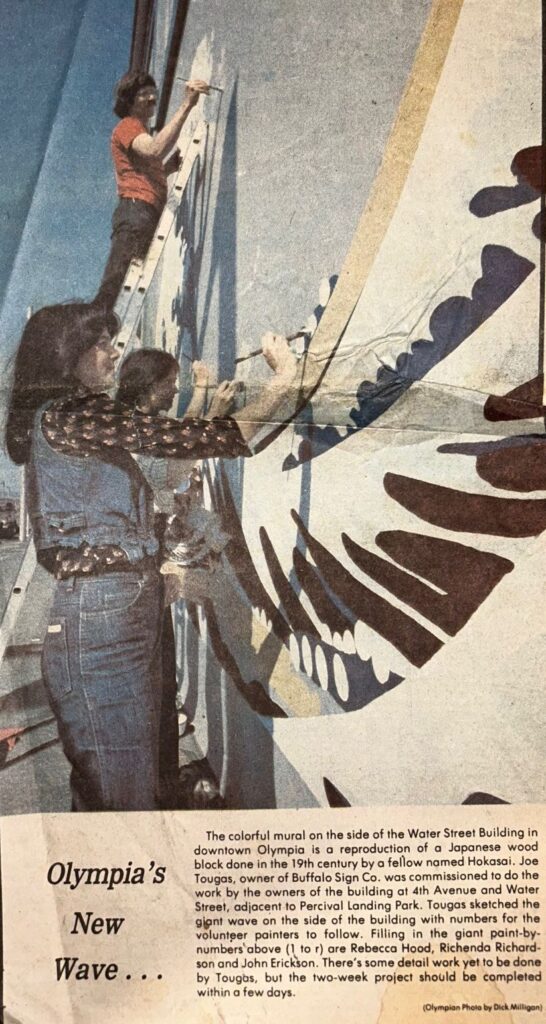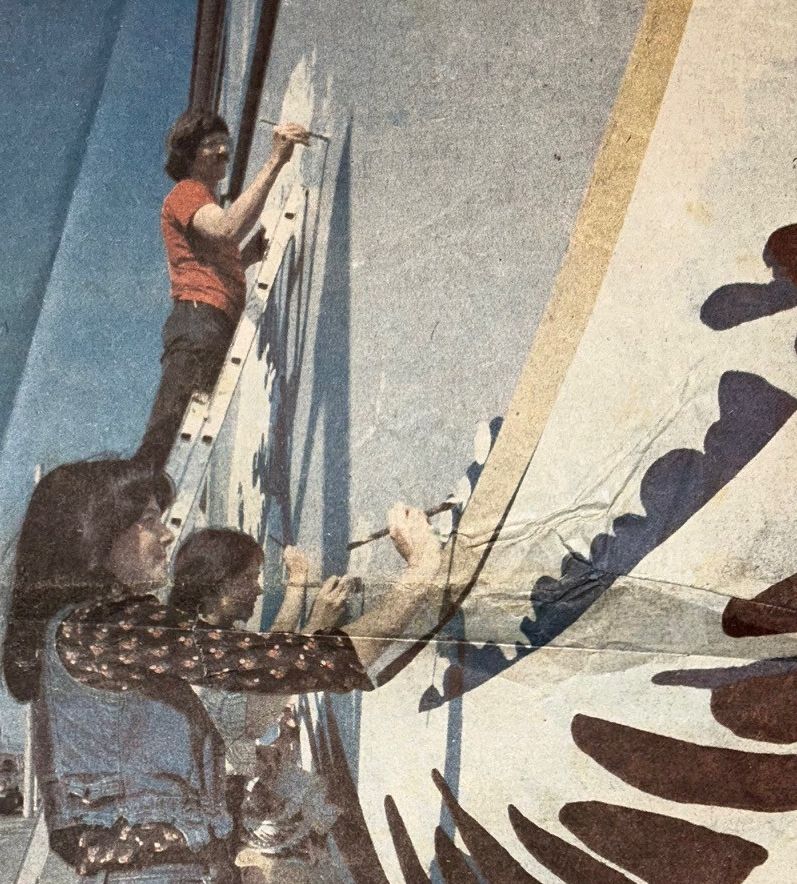ARTS
Joe Tougas and The Great Wave Mural
By Anna Schlecht

Back in 1979, Joe Tougas had a big idea. He decided to recreate a classical Japanese artwork called, “The Great Wave off Kanagawa” by the 19th century Japanese Woodblock artist Hokusai, and he knew the perfect spot—the West-facing wall of what was then called the Water Street Building at the corner of Fourth Avenue West and Water Street.
In those days, Joe had a business called, “Buffalo Signs” with a studio that was located in the Water Street Building and the West-facing exterior wall was on one of the busiest corners. While this mural made a significant impact at the time, no one anticipated that it would become Olympia’s most iconic mural, a public artwork that would last nearly half a century.
Part of Joe’s inspiration came from the existing mural on that wall. One of the other tenants in the building, the Bike Stand, had already commissioned a bicycle-themed mural on that wall. But since the bike store had moved to a new location, other artists moved into that corner spot. And all of the artists in the building liked the idea of a new mural that reflected the artists.
This was not a small project. The wall was over 15 feet tall by 15 feet wide. “I sketched out the image to create an outline,” said Joe, “and then I created a color chart showing where the various blues, grays and whites would go.” This made it easier to paint, and easier to get other folks to help him. “I would recruit passersby to come pick up a brush and help me paint,” said Joe. “The entire mural took about a week and a half to finish.”
Richenda Richardson, one of the artists in the building, remembers the Olympian came out to do a story. “It was a big deal at the time,” While it may not have been the first mural in Olympia, it was the first that wasn’t created as an artistic business sign.
Joe had come to Olympia after dropping out of Gonzaga University where he studied visual arts and philosophy. He was invited here by Richenda and Bill Richardson, who welcomed him to come live on their hippie farm—Cold Comfort. While Joe didn’t go to school at Evergreen right away, he was immersed in the community drawn together by the school, including many other artists.
One of these artist-neighbors was Tom Anderson. In 1973, Tom and several artist friends established an arts studio they called Mansion Glass in the Water Street Building. Soon, this building became an arts hub because of its central location but mostly because of the cheap rent.
The rent was cheap for a couple reasons—the building was in pretty rough shape and the neighborhood had tanked because most of downtown’s anchor businesses relocated to the newly developed Westside shopping mall.

Tom was one of the original artists who gathered their resources to actually buy the building. “Mansion Glass was renting the upstairs for about $50 a month. It had been unoccupied for years and in severe disrepair. We were urged to move there from my basement on East Bay Drive by Ray LaForge who had his bike shop called the Bike Stand downstairs in the little space that is now Hung’s Pho restaurant. When Washington Natural Gas moved out of the corner space, Ray moved his bike shop there.
When he moved to Washington Street where Bill and I were, Childhood’s End moved into where they are now and that’s when we bought the building in 1978. We bought the building to avoid random rent increases and to merely have a place to work. We realized that collectively we could come up with the ten thousand dollar down payment. Mansion Glass had just completed our biggest commission and we put the entire profit of 5k in the down payment.”
Ultimately, Joe stopped making signs and moved his studio up to the second floor. Mansion Glass relocated to a building on Washington Street. Bill and Richenda Richardson founded Childhood’s End The results of Joe Tougas’s work with friends has been appreciated for decades. According to Stephanie Johnson, the Arts Program Manager for the City of Olympia, “This mural has remarkable staying power and is one of the few community murals to have lasted more than a decade. It is certainly the only mural to remain in Olympia for nearly 50 years. It continues to be an iconic image at the gateway to downtown from the West, drawing from one of the most recognizable and enduring images in the world.”

Joe’s mural was recently repainted by Austin Michael Davis, an Asian American artist who worked closely with Joe to fully clean and restore the mural. In an act of restorative justice, the mural was rededicated to the contributions and perseverance of people of Japanese heritage in the greater Olympia area in recognition of the devastating impact of the race-based internment during WW2.
We encourage readers to contact us with comments and corrections. Disclaimer

